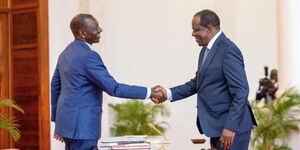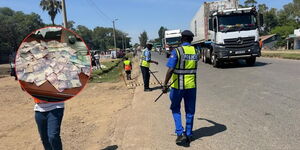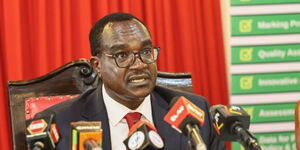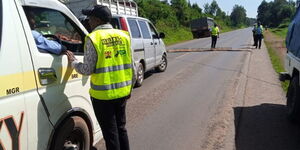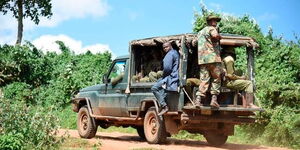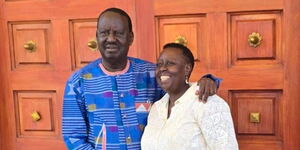The growing ageing population in Kenya continues to put further pressure on families and the State to provide quality livelihoods for the senior citizens.
The government currently runs three cash transfer programmes to poor and vulnerable groups.
They include orphans and vulnerable children and people living with severe disabilities.
Read on to find out how the Inua Jamii programme is set to uplift the lives of poor and vulnerable citizens of Kenya through regular and reliable bi-monthly cash transfers.
What is Inua Jamii?
Inua Jamii is the Government of Kenya’s (GoK’s) flagship National Safety Net Program (NSNP) for the beneficiaries of:
i.) Cash Transfer for Orphans and Vulnerable Children (CT-OVC)
ii.) Older Persons Cash Transfer (OPCT)
iii.) Persons with Severe Disabilities Cash Transfer (PWSD-CT)
iv.) Hunger Safety Net Programme (HSNP)
What is the value of the cash transfer amount paid to the household or beneficiary?
Ksh 2,000 per month (Ksh 4,000 is paid bi-monthly) to CT-OVC, OPCT and PWSD-CT beneficiaries or households.
Ksh 5,400 is paid bi-monthly to HSNP households.
What are the advantages of Inua Jamii?
Inua Jamii offers a common operational platform to the (above-mentioned) four cash transfer program beneficiaries to conveniently and efficiently:
i.) Access their cash transfer payments on a bi-monthly basis.
ii.) Stay informed about their rights and responsibilities.
iii.) Lodge complaints, grievances and make updates in the beneficiary record and receive feedback.
What are the eligibility criteria of the four cash transfer programs?
i.) Cash Transfer for Orphans and Vulnerable Children (CT-OVC) is for:
An extremely poor household with one or more OVCs as a permanent member.
A household with a caregiver who is chronically ill and/or unable to perform his/her duties.
A household not benefiting from any social assistance programme.
ii.) Older Persons Cash Transfer (OPCT) is for an older person who is:
A Kenyan citizen, 70 years and above
Not receiving pension
Not enrolled in any other cash transfer program
Residing in a particular location for more than a year
iii.) Persons with Severe Disabilities Cash Transfer (PWSD-CT) is for an extremely poor household:
Having a person with a severe disability (PWSD), who is a Kenyan citizen.
Not enrolled in any other cash transfer program.
Residing in a particular location for more than a year.
iv.) Hunger Safety Net Programme (HSNP) is for:
Vulnerable and poor households of Northern Kenya, residing in the poorest arid counties of Turkana, Marsabit, Mandera and Wajir.
How does Inua Jamii operate?
Inua Jamii is managed from the national level under the Ministry of Labour and Social Protection (MLSP) and the Ministry of Devolution and ASAL (MoDA).
It mainly works through the staff of local County and Sub-County offices and a network of Beneficiary Welfare Committees (BWCs) in each location.
Additional support is provided by the local administration, including Chiefs, Assistant Chiefs and community members.
Who are the local Government officers to facilitate beneficiaries of Inua Jamii?
The officers at the County and Sub-county offices include:
i.) County Coordinator (CC) to provide administrative support to the sub-county offices.
ii.) Sub-county Officer (SCO), including Children Services Officer (CSO) and Social Development Officer (SDO) who support the implementation of cash transfer programs and engagement with beneficiaries.
iii.) Staff from Project Implementation and Learning Unit (PILU) to assist the beneficiaries of HSNP in the four counties of Turkana, Wajir, Mandera and Marsabit. HSNP is managed by the National Disaster Management Authority (NDMA).
What is the role of Chiefs and Assistant Chiefs?
Chiefs and Assistant Chiefs act as ‘Inua Jamii ambassadors’ and ‘information resource persons’ for beneficiaries and their caregivers.
They regularly hold ‘Barazas’ to provide information on the cash transfer programs.
Specific responsibilities of Chief and Assistant Chiefs include:
i.) Provide security to the program implementers during various program activities.
ii.) Report about the misuse and disputes related to cash transfers to sub-county officers.
iii.) Collaborate with the BWC and SCO in the arbitration of cash transfer disputes.
iv.) Help beneficiaries to report cases of ‘birth and death’ in a family.
What is a Beneficiary Welfare Committee (BWC) and what is its role?
A Beneficiary Welfare Committee (BWC) is a group of representatives of beneficiaries of all cash transfer programs at the location level, who work as a link between the beneficiaries and officers on matters related to cash transfer programs to ensure community participation and ownership.
BWCs organize meetings and information-sharing sessions to educate cash transfer beneficiaries about their rights, responsibilities and entitlements.
BWC members are the first contact points to respond to beneficiaries if they seek any information, have complaints or need to update their information/record with the cash transfer program.
How does Inua Jamii identify eligible beneficiaries?
Inua Jamii cash transfer beneficiaries are identified through an objective and transparent process that includes:
i.) Community sensitization through Barazas and engagement activities.
ii.) Mobilization of the potential beneficiaries to inform them about the eligibility criteria of a particular cash transfer program.
iii.) Registration, validation and confirmation of eligible beneficiaries.
iv.) Enrolment of eligible beneficiaries into a cash transfer program and opening of a personal Inua Jamii bank account.
v.) Issuance of a payment card to receive cash transfer payments
What is the geographic coverage of Inua Jamii cash transfer programs?
Inua Jamii reaches out to the beneficiaries of CT-OVC, OPCT, PWSD in all 47 counties in Kenya up to location level.
For HSNP, the program only serves the counties of Turkana, Marsabit, Mandera and Wajir in Northern Kenya.
Inua Jamii Bank Account and Payment System
How are Inua Jamii cash payments delivered to the beneficiaries?
Inua Jamii cash transfer payments are delivered into an Inua Jamii bank account of a beneficiary after every two months.
Beneficiaries can access their payment at their own convenience.
How does a beneficiary register into the Inua Jamii payment system to open a personal Inua Jamii bank account?
Inua Jamii offers a one-stop-shop facility of ‘Inua Jamii Mobilization Centre’ which are set up at the local level.
Beneficiaries are invited to visit the Centre according to a given schedule to register into the Inua Jamii payment system and open a personal bank account.
How does a beneficiary know about the Inua Jamii Mobilization Centre?
A local BWC committee member or Sub-county officer informs beneficiaries and their caregivers on how and where to enrol into the payment system through an Inua Jamii Mobilization Centre.
What happens at the Inua Jamii Mobilization Centre
i.) Beneficiaries and Caregivers present themselves in-person (physically) at the nearest Mobilization Centre along with a valid and original National Identity Card.
ii.) Upon verification of beneficiaries’ record, they are allowed to register with a Bank of their choice to open an Inua Jamii Bank Account and receive a payment card.
(For more information, please see the information leaflet on ‘Inua Jamii Bank Account and Payment System’)
Are there any special arrangements for Persons with Severe Disabilities (PWSDs) at the Mobilization Centre?
PWSDs are given priority over others and served with prompt attention at the Centre.
Which banks are authorized to open a bank account for beneficiaries?
The four banks listed with Inua Jamii are:
i.) Co-operative Bank
ii.) Equity Bank
iii.) Kenya Commercial Bank (KCB)
iv.) Post Bank.
Do beneficiaries themselves select a Bank of their choice?
Yes, a beneficiary has the freedom to choose a bank from the four authorized banks.
Are beneficiaries given any criteria to select a bank?
There are no specific criteria or conditions to select a bank.
All four banks offer similar and equitable services.
Beneficiaries can, however, choose a bank that they find most convenient to do transactions with.
Can a beneficiary register with more than one bank?
No. A beneficiary can only register with ONE bank from the four authorized banks.
In case a beneficiary is found with more than one bank accounts (from among the authorized banks) they may have to exit from the program.
What happens if a beneficiary is not satisfied with the bank that they register with?
If a beneficiary is dissatisfied with a bank, they can switch to another bank (from among any of the four authorized banks) after a period of one year.
What happens after a beneficiary opens an Inua Jamii bank account?
i.) The beneficiary receives a payment card from the Bank.
ii.) Cash transfer money is credited to the bank account by Inua Jamii after every two months.
iii.) The beneficiary can draw the money out, using the payment card anytime from anywhere through any of the available payment points/methods of payments (ATM, authorized Bank Agent, from the counter of a Bank, Mobile Phone Banking).
Are there any bank charges applied when the money is drawn out from the bank account?
Inua Jamii Bank Account allows for two free withdrawals every two months.
After this, any additional withdrawal during the same two (consecutive) months period.
What happens if a beneficiary does not withdraw money for a period of six months?
If a transaction is not made within six months (3 payment cycles), your account will become dormant.
How do you reactivate a bank account after it becomes dormant?
In order to reactivate a dormant bank account, the bank will require a beneficiary’s proof-of-life through the use of the beneficiary’s biometrics (fingerprints).
Can a bank account be opened or reactivated by using someone else’s National ID Card?
No, the bank account will only be opened or reactivated using the original and valid ID Card of the individual beneficiary who must present him/herself to the bank officer.
What are the payment points (methods of payment) to collect the money from?
A beneficiary can collect the money from:
i.) The nearest ATM (using the payment card), whenever they want to do so.
ii.) The nearest authorized Bank Agent (using the payment card)
iii.) Over-the-counter of the nearest branch of the bank (using the payment card)
iv.) Mobile bank agent (for beneficiaries who have a mobile phone and know how to use it for mobile banking).
What are the pre-requisites for mobile phone banking?
A beneficiary can opt for mobile phone banking, if they:
i.) Have a personal mobile phone.
ii.) Have received a PIN code for mobile banking.
iii.) Go to the nearest authorized mobile agent to draw the money out.
You should remember your PIN at all times and MUST NOT disclose it to a stranger.
(For more information, contact your Bank or call Inua Jamii Helpline 1533)
What are the benefits of Inua Jamii Bank Account?
i.) Inua Jamii Bank Account is a normal bank account that can be used to save and receive money from any source (in addition to Inua Jamii).
ii.) You can withdraw money from the bank account or its nearest agent whenever you want to on a need basis.
Inua Jamii Grievance and Case Management System
What if a beneficiary encounters an issue or has a complaint with Inua Jamii?
i.) You have a right to lodge a complaint with Inua Jamii if you receive unsatisfactory service at a payment point or encounter any other issue that needs to be resolved.
ii.) Inua Jamii has introduced an accessible and efficient mechanism to resolve complaints and enable updates of the poor and vulnerable beneficiaries
What are the methods to lodge a complaint?
i.) Call Inua Jamii Toll-Free Helpline 1533.
ii.) Talk to a member of Beneficiary Welfare Committee, Chief or Assistant Chief.
iii.) Visit County or Sub-county office and speak to a relevant officer.
iv.) Use a dropbox facility at sub-county office.
v.) Email at inuajamii@socialprotection.go.ke
What are the timings to lodge a complaint?
Inua Jamii Toll-Free Helpline and offices are open from 8am-5pm from Monday to Friday.
What issues or events need to be reported immediately?
Issue and Who to contact
i.) If your payment card is lost or damaged – Authorized bank.
ii.) If you lose or forget your PIN Code – Authorized bank.
iii.) If you relocate to a new address – Sub-county officer.
iv.) If a beneficiary dies – Sub-county officer, a BWC member.
v.) If you have a new caregiver – Sub-county officer, a BWC member.
vi.) If you are charged a fee at any of the payment points – Call 1533; Sub-county officer.
vii.) If your payment is delayed Call 1533; Sub-county officer, a BWC member.
viii.) In case of any dispute related to cash transfer – A BWC member, Chief, Sub-county officer.
ix.) In case of any other issue related to payment or your status as a beneficiary of Inua Jamii. Call 1533; Sub-county officer, a BWC member
What to do, if you need more information?
Call Inua Jamii Toll-Free Helpline 1533
What is normal response time?
The response time may vary with respect to the nature of a complaint or if it is a unique case.
However, they respond to complaints, grievances and requests for updates in a timely manner.
Social Assistance Unit (SAU)/ Contacts
NSSF, Block A, Eastern Wing,
1st Floor Bishops Road, Milimani, Nairobi, Kenya.
P.O. Box 40326 – 00100
Tel: +254 (0) 2729800
Mobile: +254 (703) 830957
Fax: +254 020 2726497
Email: ps@socialprotection.go.ke/inuajamii@socialprotection.go.ke
Inua Jamii Toll-free Helpline – 1533
Offices and helpline are open (Monday to Friday | 8am – 5pm).

